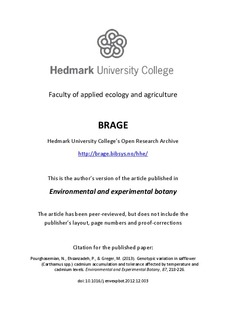Genotypic variation in safflower (Carthamus spp) cadmium accumulation and tolerance affected by temperature and cadmium levels
Journal article, Peer reviewed
Permanent lenke
http://hdl.handle.net/11250/134522Utgivelsesdato
2013Metadata
Vis full innførselSamlinger
Originalversjon
Pourghasemian, N., Ehsanzadeh, P., & Greger, M. (2013). Genotypic variation in safflower (Carthamus spp.) cadmium accumulation and tolerance affected by temperature and cadmium levels. Environmental and Experimental Botany, 87, 218-226. doi: 10.1016/j.envexpbot.2012.12.003 10.1016/j.envexpbot.2012.12.003Sammendrag
Soil pollution is a world-wide problem, with heavy metals being a major part of the concern. To investigate the effect of temperature on cadmium (Cd) uptake and translocation, as well as Cd tolerance in wild and cultivated species of safflower, a hydroponic experiment was conducted under controlled conditions. The responses of four wild genotypes (Isfahan, Arak, Azari, and Shiraz) and four cultivated genotypes (AC-Sterling, 2811, Saffire, and C111) of safflower to nine levels of CdCl2 (0, 0.5, 1, 5, 10, 20, 50, 100, and 500 μM) in solution were examined under two temperatures (18 and 23 °C). Cadmium sensitivity was determined using the Weibull model on the total dry weight of the plants. Cadmium uptake and translocation were analyzed on 1 μM Cd treated plants. Results revealed that safflower genotypes differed in terms of uptake, translocation, and tolerance to Cd, with AC-Sterling and Arak indicating the most and the least tolerance to Cd, respectively. Relative Cd uptake and Cd concentration in roots and shoots increased with an increase in temperature in all genotypes, with the exception of AC-Sterling. Net accumulation of Cd via root increased with an increase in temperature for the wild Azari and the cultivated 2811, Saffire, and C111, though it decreased for the rest of genotypes. Cadmium translocation to shoots significantly increased with increased temperature in all genotypes. Cadmium translocation from roots to shoots in cultivated genotypes was significantly greater than in wild genotypes. Root Cd concentration in wild genotypes was significantly greater than in cultivated genotypes. It seems that wild and cultivated species of safflower differ in their response to Cd. Furthermore, temperature may affect the plant's tolerance to Cd, probably through accompanying changes in Cd uptake and translocation from root to shoot.
Beskrivelse
This is the postprint version of the article published in Environmental and Experimental Botany. The published article can be located at the journal's webpage
